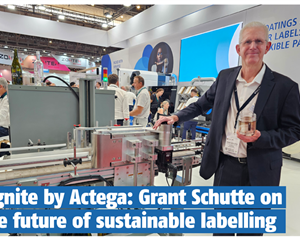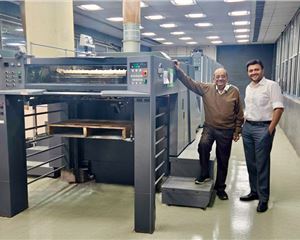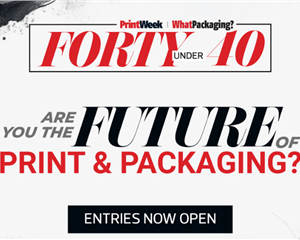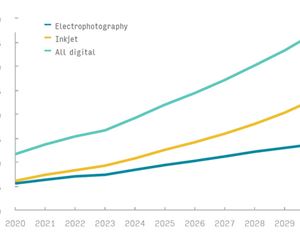Label players showcase their strengths at LMAI conference
The seventh edition of LMAI conference 2025 took place from 3 to 6 July, with the committee members inaugurating the three-day event at the Fairmont in Udaipur by lighting a lamp.
07 Jul 2025 | By Noel D'Cunha
This year’s LMAI conference also marked the launch of an anthem song commemorating the Association's silver jubilee.
On the first day of the event, Stephane Royere, head of business area, packaging and print, Kurz, delivered the keynote address. In his speech, Royere discussed how to embellish with impact. “Emblishment is expensive, inflexible and expensive, but not with Kurz,” he said.
Earlier in the day, Rajesh Chadha, president of the Label Manufacturers Association of India (LMAI) delivered the presidential address.
VS Raveendran of Sel Jegat, Sivakasi, was conferred with the LMAI Lifetime Achievement Award 2025.
Earlier, LMAI had announced that registrations for the LMAI conference were officially sold out.
The conference brings together the Indian label fraternity, including label converters and leading industry suppliers from India and abroad. Backed by prominent sponsors such as Kurz India as Platinum sponsors and Avery Dennison as Elite sponsors, alongside other industry supporters, the event promises a robust platform for networking and knowledge sharing.
Stephane Royere, head of business area packaging and print, Kurz, in his keynote at the LMAI conference, discussed embelishing with impact. Emblishment is inflexible and expensive, but not with Kurz, he said.
Discussing how neuromarketing meets the art of labelling, Royere said, effective labels use eye-catching designs and advanced printing techniques to capture consumer attention. “Classic finishes such as gold or silver, eye-catching colours and special effects, all add a unique touch to each label. He said 82% of a sample of 2,000 consumers relied primarily on the label to choose their favourite wine.
Royere discussed different Kurz products such as hot stamping H&M; cold transfer KPQ XU and Distorun, a machine; and Kurz DM-Uniliner 2D and 3D (inkjet digital embellishing machines) among others.
“Mindset is the first boundary.” Jitesh Mehta of Avery Dennison said. “Staying in your comfort zone means missed opportunity. New growth will only come from new products, geographies and tech.” Talking about India’s next big packaging growth, Mehta talk about wet wipes, pharma exports and digital twins. He urged converters to spot global trends and bring them home. “Don’t wait for demand. Create it,” he said. From InsideX to the Knowledge Centre, Avery Dennison offers the bridge to digital, sustainable, high-margin packaging.
In their presentation, Ranesh Bajaj, managing director, Vinsak and Naoki Ogawa, sales director at Iwasaki, said, “Offset isn’t dead; it’s more relevant than ever for short to medium runs.” Vinsak and Iwasaki argued it’s still the lowest cost of origination, with automation that rivals digital. “Intermittent offset lets converters print multiple SKUs with minimal changeover. No gears, no cylinders, just adjust the feed length. It's fast, lean and ideal for high-SKU segments,” they said, adding, “Modern offset is built for smart operators, not specialists. Waterless tech, servo-driven controls, and register automation make it easy to run and more consistent than ever.”
A Appadurai, country business manager, Indigo and inkjet business solutions at HP, said, “Digital print is no longer a chiller business. With speeds of 120 metres per minute and costs near flexo, HP's Indigo V12 is taking digital mainstream—and killing waste,” he said. “D2C and quick commerce are rewriting packaging demands. Small batches, fast turnarounds and premium pouches are the new normal. Digital’s the only way to keep up.” HP’s six-in-one digital press replaces flexo, gravure, screen and more. Labels, pouches, sleeves, and cartons — all from one machine. One investment, multiple revenue streams. He concluded, “AI is not the future—it’s in your press. Auto calibration, defect detection and remote support mean anyone can run the job, anytime. Digital is now plug-and-profit.”
Thomas Schweizer, global sales head (CSO) at Gallus Group, said, “Hybrid is not a compromise, it's the sweet spot." Schweizer showed how modular hybrid presses are cutting TCO by up to 25%. Operator crisis in print? Gallus' answer: automation that works like a smartphone. Attract Gen Z, eliminate job change chaos, and keep presses running clean. With building block modularity, Gallus lets converters switch from boutique runs to high-volume flexo, without retooling. “From matte-to-gloss at the push of a button to screen units that retrofit anywhere, Gallus is bringing luxe labels to the masses,” he said.
Supachai Theravithayangkura, technical director Asia Pacific, XSYS, said 83% of Indian consumers now consider packaging’s environmental impact crucial, outpacing global sentiment. APAC isn’t catching up, it’s setting the tone. On PET vs glass vs aluminium, he said, there’s no perfect pack. Sustainability is about trade-offs, not hashtags. He said XSYS launches 30% plant-based Eco series with zero solvents and full automation. “Every step leaves a footprint, no matter how small. From Kung Fu Panda to packaging sustainability, XSYS makes sure the next footprint’s greener,” he said.
Ankit Madan, senior manager product (industrial printers) product life cycle management, Konica Minolta Business Solutions India, said digital label printing is no longer the future, it’s tier 3 India's startup engine. Simplicity plus speed plus service is the new formula.He gave the example of a 20-bottle order turned into 16 million for a water brand using Konica Minolta digital presses. “That’s what happens when customisation scales,” he said. With no special media or pre-coating required, Konica Minolta’s digital presses offer a plug-and-play model for short-run label success. Variable data printing, white opacity, and click-based models: digital label presses are finally ticking all the boxes for India’s converters.
Flint Group had two speakers: Pierre Dogliani, R&D innovation manager narrow web, Flint Group Sweden who spoke on curing technology and Hans Gerinchkx, global vice-president for Flint Group Digital, who spoke on digital technology. Pierre Dogliani said, “LED curing doesn’t just save energy, it opens up thinner substrates, faster setup, and lower maintenance for converters chasing agility and ROI. Flint’s dual-cure inks enable seamless transitions from mercury to LED without dual inventories, making regulatory and commercial sense. Hans Gerinchkx, global vice president for Flint Group Digital, said, “while going digital, don’t just migrate jobs, reinvent your label business. Efficiency gains alone won’t justify the investment. Create new value.” He said the mid-market digital press segment now drives most global label growth, faster, more flexible, and hybrid-ready. “Your first digital press is never plug-and-play. Pick partners who understand print, workflow, and finishing, or pay the learning tax later,” he said.
Natasha Jaychandra director at Veepee Graphic Solutions, making her third career presentation and the first at the LMAI conference, said, ECG isn’t about colour embellishment, it’s a full-spectrum strategy that slashes ink waste, boosts consistency, and wins back press hours. “With 90% Pantone coverage and Delta E <2, ECG closes the gap between brand dreams and production reality—without spot inks, she said, “Faster changeovers, fewer wash-ups, and fixed ink sets make ECG a sustainability win as much as a colour upgrade.”
FIG presentation was made by Gourav Roy of FIG, Florian Stroe (Mark Andy) and Krisyanto Ekokurniawan (Luster), the two companies FIG represents. Gourav Roy said, “India’s label printers don’t need machines—they need ecosystems. FIG’s edge is in stitching together global tech into seamless, press-to-pack integration.” Florian Stroe said, “Inline digital hybrids from Mark Andy collapse print, convert, and embellish into a single-pass race car. Indian converters now demand speed without setup stress.” Krisyanto Ekokurniawan said, “Luster’s AI-powered inspection tools are enabling zero-defect dispatches. For pharma and export labels, precision isn’t a perk — it’s a protocol.”
Hardik Patel, national sales head at Toppan Speciality Films, said, “Recyclability isn’t enough. Today’s packaging must be certifiably recyclable, perform under pressure, and reduce carbon. Mono is the way forward.” Toppan’s mono-material films mimic the strength of PET/foil combos, minus the landfill fate. High-barrier, clear, and fully recyclable. Patel said India’s EPR laws are sparking packaging overhauls. Converters who simplify structures and think circular win brand trust. “The future is collaborative: when converters join design-stage discussions, recyclability, printability, and compliance align from day one,” he asid.
Eisuke Morishita, senior manager, sales and marketing (C&I Printer) at Epson India, said, “Digital print shouldn’t just be fast, it should be perfect. PrecisionCore tech ensures every dot, font, and barcode lands right.” Epson’s UV inkjet platform is vertically integrated, from heads to RIP to ink. That means fewer surprises and tighter colour control. High-opacity white, variable data, and low-migration UV inks make Epson’s SurePress ideal for pharma, cosmetics, and niche FMCG labels.
Abhay Datta, managing director, UV Graphic Technologies, the manufacturers of UltraFlex range of presses, said, “We don’t just build presses, we engineer ecosystems.” The UltraFlex AI flexo series puts Noida on the global flexo map. First-pass register, AI plate counters, and 30-second curing swaps, UV Graphic’s machines now out-innovate many European peers. With 160+ presses sold, 4,000 LED-UV systems installed, and exports to Europe, UV Graphic proves Indian flexo isn’t just catching up, it’s leading.
Nitish Verma, general manager- marketing speciality films and head, offline coated films and labels (India business) at Chiripal Polyfilms, said, ““India produces over 1,30,000-mt of BOPP every month. This isn't just a face stock, it's the backbone of consistent, scalable label production.” Chiripal’s five-layer BOPP films, now used in 148 countries, solve real-world issues like curl on HDPE and static in sheetfed. Substrate engineering, not just coating. With 16,000 MT of BOPP exported globally and 5,75,000-mt in combined capacity, Chiripal’s printable, recyclable films are raising India’s label game. Chiripal backs its films with 20+ global certifications, 30% PIR integration, and full compliance for food, pharma and EPR. “We’re not vendors—we’re converters’ co-pilots.”
“India doesn’t need more jobbers , it needs thinkers,” said Pawandeep Sahni of Omet. “Design is a business model. Printing is just execution.” Omet’s hybrid presses now enable Indian converters to personalise, embellish and finish inline — shrinking turnaround from days to hours. “Stop chasing scale. Start building specialisation,” Sahni said. A niche label with high shelf impact beats 1 million generic runs. “In 2025, your biggest asset isn’t a press — it’s a mindset,” he added. Omet now co-creates value with clients beyond CAPEX — into Go-to-market (GTM), design, and speed.
Marcus Greenbrook, director of international sales at GEW (UV), said, “LED UV cuts energy use by up to 70%. A mercury system burns 30–40 kWh/station. LED uses just 10–15 kWh — with cooler, cleaner prints.” GEW’s ArcLED hybrid lets you switch between UV and LED instantly. “Over 2,000 global retrofits, 60+ in India in 2 years. Plug in, power down.” LeoLED lamps last 10x longer than mercury bulbs. No reflectors, no shutters, no hot spots. Just 30,000+ hours of steady curing. “In 2025, converters must track power per job,” said Greenbrook. “LED enables real-time energy analytics. Mercury can’t.”
Devin MaCart, global product manager at Maxcess (Rotometrics), said, ”A 45-min roller setup was automated to 8 mins. Waste dropped 10%, throughput rose 25% — same staff, better flow.” He added, “Automation is enablement, not replacement.” One die-cutting upgrade freed up operators for higher-value work, boosting capacity without adding headcount.
Mark Herrtage, CFO digital printing and Asia business development at Domino Printing Sciences, said, “Digital reduces setup waste by 20% or more. No plates, no makeready — just profit-ready labels.” Domino’s N610i has 350+ installs globally and within the Domino portfolio, dominating India’s mid-tier label segment. “It’s the money-making machine,” said Herrtage. Digital enables 20+ label variants per day — without downtime. “This isn’t future tech. It’s solving today’s SKU chaos,” he said.
Manjusha Singh, CEO, Siegwerk India, said, ““We now trace every Siegwerk ink batch back to its raw material, operator and test report — that’s transformation.” Siegwerk India clocked 1,000 days with zero lost-time incidents. “Safety isn’t a checklist — it’s culture,” Singh said. Siegwerk’s sustainable inks now enable label de-inking in real-world Indian recycling lines. Singh said: “We’re designing for recyclers, not awards.”
LMAI conference 2025 day three began with a panel discussion on the topic: Narrow web label converting expanding to diverse applications. Moderated by Harveer Sahni, chairman, Weldon Celloplast, the panelists were: Mehzabin Nair, managing director, Skanem India; Priyata Raghavan, deputy CEO, Sai Packaging; Ankit Gupta, Holostik; Denver Annunciation, director, strategic initiatives, Janus International; Hemant Paruchuri, director, Pragati Pack (India); and Stephene Royere, head of business area packaging and printing international sales and marketing, Kurz India.
Harveer Sahni said, “Premium isn’t what glitters — it’s what delivers. On time, on brand, on purpose.” Sahni urges the industry to look beyond embellishment and measure premium through consistency and intent.”
Priyata Raghavan said, “Luxury starts with a feeling — not foil. Packaging must speak emotionally, even before it dazzles visually. Sai Packaging is designing packs that trigger trust, not just trigger shine.”
Mehzabin Nair said, ““Sometimes white space is the most premium thing you can use. Today’s Indian consumer connects more with quiet sophistication than loud glamour — design restraint is in.”
Stephane Royere said, ““Our PET-free transfer foils saw a 30% jump in APAC adoption. Kurz is proving that embellishment and eco-performance can co-exist — India is now leading the sustainable premium wave.”
Hemant Paruchuri said, “You can’t deliver luxury if your quality depends on luck. Paruchuri calls for tighter process control, automation and press discipline to make premium packaging scalable.”
Ankit Gupta said, ““Security must be an invisible art. Holostik’s new biodegradable holograms blend authentication with design, proving that brand protection can also be beautiful.”
Denver Annunciation said, ““When we prototype together, we win faster. Annunciation pushes for cross-company packaging labs — where creativity meets feasibility early and often.”
Sprint Xu, global sales director, Weigang, the presenter could not travel, hence, Ruhi Shah of Global Graphics, representing Weigang made the presentation on the topic: Powering the future of smart printing. Sheikh said, “One Weigang user cut job changeover waste by 22% using smart tension-learning. That’s not automation. That’s profit. Weigang presses can switch jobs in under 30 seconds. In a world of micro-runs, smart is the new fast. India is on Weigang’s radar — with users in Mumbai cutting makeready time by 32% and reporting zero missed deadlines.”
Dhanush Reddy Kotha, executive director, Stic On Paper, said, “Stic On’s plant makes 10,000-MT/month of pure acrylic adhesives — now that’s India’s answer to global compliance.”
Thillai Ganapathy, Esko Graphics India, said, “Using ECG, Esko users cut ink changeovers by 75% and gang jobs effortlessly. Esko’s Phoenix AI ganging tool slashed prepress layout time by 40%. Pre-press isn’t a bottleneck anymore — it’s the growth lever.”
Shaju John, DuPont Specialty Products India, said, “”DuPont’s Cyrel Fast thermal platemaking brings plate readiness down to under 30 minutes, solvent-free. It’s faster, greener and press-ready. One DuPont Fast plate clocked one-million + impressions with no quality drop. Flexo longevity just got a durability upgrade.”
Manish Hansoti, managing director, S Kumar Multiproducts, said, “Uptime beats bragging rights. We skipped a European press we couldn’t run — and doubled down on machines our people loved.”
Aarjav Hansoti, director, S Kumar Multiproducts, said, “Intermittent offset lets us switch repeat lengths without plate change. We run 10K + 3K label jobs — no sweat.”
Tania Hansoti, marketing director at S Kumar Multiproducts, said, “Operator happiness is ROI. A well-lit pressroom, easy UI and 2AM tech support matter more than spec sheets.”












 See All
See All